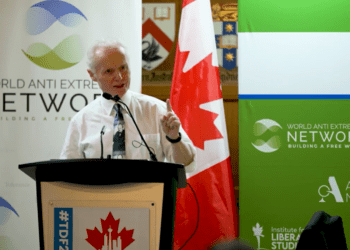This article originally appeared in the Japan Times.
By Stephen Nagy, July 3, 2025
With Canada Day upon us, Ottawa faces unprecedented challenges to the nation’s sovereignty and prosperity, and a stark reality: The international order that enabled Canada’s middle power diplomacy for seven decades is dead.
The return of great power competition, exemplified by recent American economic coercion, persistent Chinese economic pressure and foreign interference demands a fundamental transformation of Canadian foreign policy. The choice is not between independence and alignment, but between strategic adaptation and irrelevance.
The events of the past six months have crystallized what should have been obvious for years. When U.S. President Donald Trump imposed his 25% tariffs while musing about Canadian statehood, he merely articulated what American actions have long implied: that Washington views allied relationships through a transactional lens where power asymmetries define outcomes.
Similarly, when Beijing targeted Canadian agricultural exports in response to Ottawa’s criticism of its Hong Kong policies or the lawful arrest of Huawei executive Meng Wanzhou, it made clear that China’s use of economic power serves the political interests of the Chinese Communist Party, regardless of World Trade Organization rules or treaty obligations.
These are not exceptions; they are the new normal. The comfortable and sometimes naive assumptions that underpinned Canadian foreign policy for decades — such as the belief that rules-based multilateralism could restrain great powers, that economic ties would ease political tensions and that middle powers were able to navigate between rival blocs — have proven dangerously misguided. Canada must now build a foreign policy rooted in the hard realities of global power politics, not the liberal aspirations of the past.
Canada has long sought to reduce dependence on the United States through diversification, particularly toward China and, thanks to an Indo-Pacific strategy, the region. This strategy fundamentally misunderstands both Canada’s structural position and the nature of contemporary Chinese power. The nation’s economic integration with the United States is not merely deep but constitutive. More than 75% of Canadian exports flow south, supply chains are continentally integrated and the innovation ecosystems of the two neighbors are inextricably linked. Geographic proximity, the United States-Mexico-Canada Agreement framework and decades of regulatory harmonization have created an economic space that transcends national boundaries.
Consider the critical minerals sector, where Canadian extraction feeds American battery production in an integrated North American electric vehicle supply chain. Or examine the artificial intelligence ecosystem, where Canadian research centers in Toronto and Montreal function as nodes in a broader network including Silicon Valley and Boston. These connections represent not vulnerability but comparative advantage, provided there is the strategic wisdom to leverage rather than lament them.
The fantasy of meaningful diversification to China ignores both mathematical realities and recent history. Even doubling Canadian exports to China would barely dent dependence on the United States while exponentially increasing exposure to Beijing’s coercive diplomacy. Moreover, China’s track record of economic punishment should disabuse policymakers of any illusions about benign commercial relations.
The pattern is clear. After Australia called for an investigation into the origins of COVID-19, China imposed steep tariffs on wine and barley imports. When Lithuania allowed the opening of a Taiwanese representative office, Beijing responded with a sweeping economic blockade. When South Korea deployed the THAAD anti-missile system, Chinese consumers boycotted South Korean businesses. When Japan detained a Chinese fishing captain, rare earth exports suddenly stopped. In every case, economic interdependence became a weapon instead of a source of stability.
The old parable of the scorpion and the frog illuminates this dynamic perfectly. Like the scorpion that stings the frog carrying it across the river, dooming them both, China cannot resist using economic leverage for political ends. As strategic theorist Christopher Ford astutely observes, beneath the “Confucian flesh” of win-win rhetoric lies the “realist bones” of a power that views all relationships through the lens of hierarchy and submission.
Canadian experiences confirm the pattern. The arbitrary detentions of Michael Kovrig and Michael Spavor after the arrest of Meng Wanzhou exposed Beijing’s willingness to engage in hostage diplomacy. Ongoing restrictions on Canadian canola based on questionable phytosanitary claims show how China uses trade regulations as tools of pressure. Most recently, Chinese cyber operations targeting Canadian critical infrastructure, though denied by Beijing, fit a broader pattern of low-level aggression meant to expose vulnerabilities without provoking direct retaliation.
To increase dependence on such a partner is not diversification but delusion. It represents the triumph of commercial interest over strategic judgment, equivalent to the frog agreeing to carry the scorpion despite knowing its nature.
The path forward requires letting go of the comfortable myth of middle power independence and accepting the harder truths of strategic alignment. This does not mean becoming a satellite of the United States but recognizing that Canadian prosperity and security depend on the success of the North American system. When U.S. President Trump questions Canadian sovereignty, he expresses — however crudely — a basic truth: In an era of great power competition, geographic neighbors must be strategic partners or risk becoming contested spaces.
Canada must move from being a free-riding critic of American power to becoming an essential partner in North American strength. This shift requires several specific actions. First, Canada should meet and exceed NATO defense spending commitments, not to please Washington but to demonstrate a serious commitment to continental security. Second, critical infrastructure protection, investment screening and technology policy should be closely aligned with American standards to create a shared security perimeter. Third, Canada must contribute in meaningful ways to joint strategic priorities, including Arctic defense, critical mineral supply and technological innovation.
Most crucially, the reflexive anti-Americanism that has long replaced serious strategic thinking in Ottawa must end. The adolescent pleasure of differentiating Canada from the United States, of positioning Canada as morally superior to American excess, is a luxury no longer affordable. When dealing with powers like China that view international relations in civilizational terms, the narcissism of small differences between Canada and America becomes not only irrelevant but dangerous.
This strategic realignment need not betray Canadian values or interests. In fact, it offers the best way to protect them. A Canada that makes meaningful contributions to North American power earns influence in Washington that far exceeds anything achieved through middle power posturing. By becoming essential to American security and prosperity, Canada can turn one-sided dependence into mutual strategic interdependence.
Consider how Australia has navigated similar challenges. Despite severe economic pressure from China, Canberra has strengthened security ties with Washington while remaining economically pragmatic. The AUKUS agreement is not a sign of Australian submission but a display of strategic creativity — using alignment with American power to boost independent capabilities. Canada needs similar innovation, possibly through a “CAUKUS” partnership that integrates Canadian Arctic expertise, critical minerals and artificial intelligence into the Anglo-American technology alliance.
The goal is not to become America’s 51st state but to make such absorption unthinkable because Canada provides more value as a sovereign partner than as a subordinate province. This requires abandoning the passive-aggressive stance of recent decades for active contribution to shared objectives. When Washington pursues semiconductor reshoring, Ottawa should offer complementary investments. When America worries about Arctic vulnerability, Canada should propose joint solutions. When the U.S. needs secure critical mineral supplies, it should present integrated continental strategies.
Canada faces a clear choice. It can cling to the comfortable delusions of middle power independence, irritating Washington while trying to court Beijing, until economic pressure and strategic irrelevance dictate the terms. Or Canada can choose strategic adaptation and transform from a free-riding neighbor into an indispensable partner in North America.
This transformation does not require betrayal of Canadian identity. Democratic values, multilateral instincts and diplomatic creativity remain strengths — but only when applied through strategic realism instead of moral posturing. The international system that once rewarded middle power activism has disappeared, replaced by great power competition where geography shapes destiny and power decides outcomes.
Canada’s future does not lie in balancing between Washington and Beijing but in recognizing that geography, economics and values have already chosen its path. The task is to make that alignment serve Canadian interests through creative statecraft rather than resentful acquiescence. The scorpion will always sting, but the eagle, however demanding, shares the same nest.
The nation should choose strategic wisdom over comfortable delusions. Its sovereignty depends not on the distance it maintains from American power but on the value it provides its big southern neighbor.
Stephen R. Nagy is a professor of politics and international studies at the International Christian University in Tokyo, a senior fellow at the Macdonald-Laurier Institute, a senior fellow at the Asia Pacific Foundation of Canada and a visiting fellow with the Japan Institute for International Affairs.






